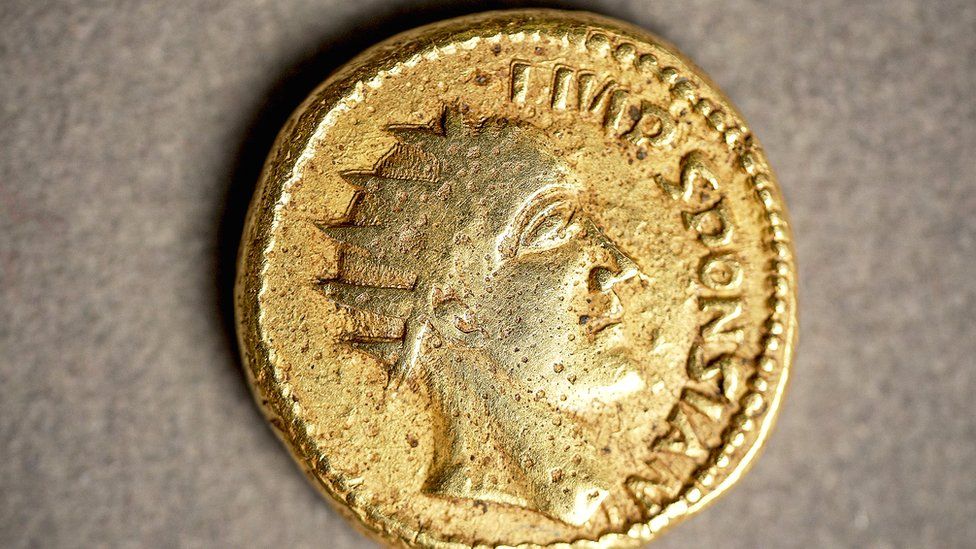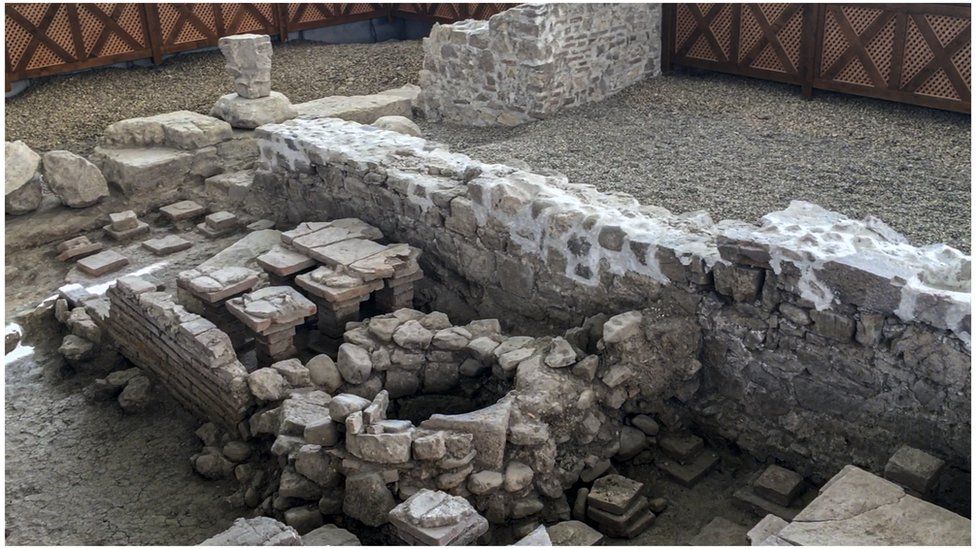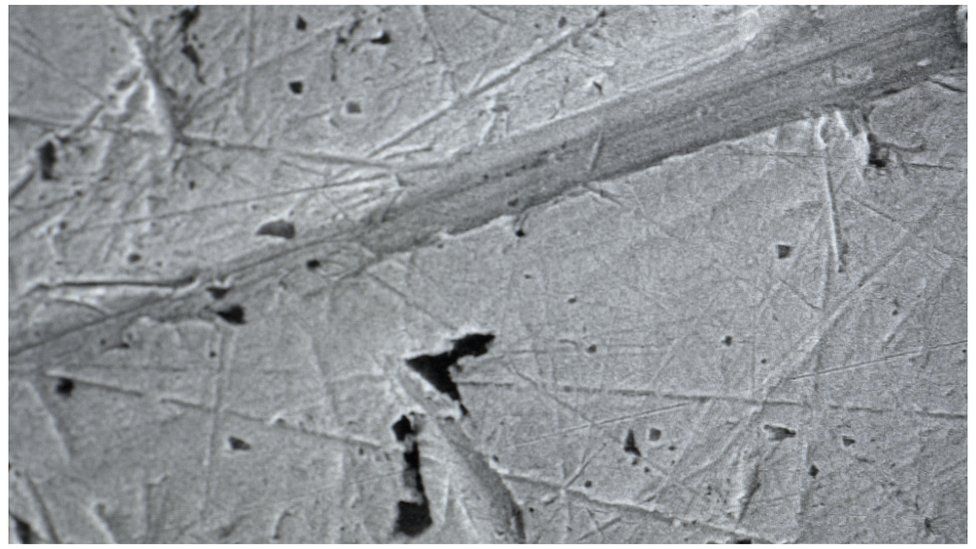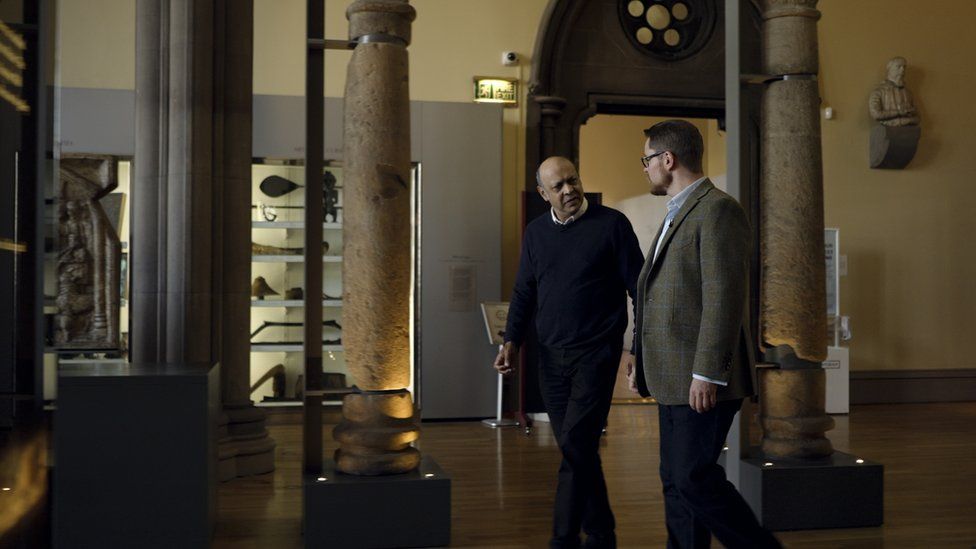Gold coin proves 'fake' Roman emperor was real
 BBC NEWS
BBC NEWSAn ancient gold coin proves that a third century Roman emperor written out of history as a fictional character really did exist, scientists say.
The coin bearing the name of Sponsian and his portrait was found more than 300 years ago in Transylvania, once a far-flung outpost of the Roman empire.
Believed to be a fake, it had been locked away in a museum cupboard.
Now scientists say scratch marks visible under a microscope prove that it was in circulation 2,000 years ago.
Prof Paul Pearson University College London, who led the research, told BBC News that he was astonished by the discovery.
"What we have found is an emperor. He was a figure thought to have been a fake and written off by the experts.
"But we think he was real and that he had a role in history."
 PAUL PEARSON
PAUL PEARSONThe coin at the centre of the story was among a small hoard discovered in 1713. It was thought to have been a genuine Roman coin until the mid-19th century, when experts suspected that they might have been produced by forgers of the time, because of their crude design.
The final blow came in 1863 when Henry Cohen, the leading coin expert of the time at the Bibliothèque Nationale de France, considered the problem for his great catalogue of Roman coins. He said that they were not only 'modern' fakes, but poorly made and "ridiculously imagined". Other specialists agreed and to this day Sponsian has been dismissed in scholarly catalogues.
But Prof Pearson suspected otherwise when he saw photographs of the coin while researching for a book about the history of the Roman empire. He could make out scratches on its surface that he thought might have been produced by the coin being in circulation.
He contacted the Hunterian Museum at Glasgow University where the coin had been kept locked away in a cupboard along with three others from the original hoard, and asked if he could work with the researchers there.
They examined all four coins under a powerful microscope and confirmed in the journal, PLOS 1, that there really were scratches, and the patterns were consistent with them being jingled around in purses.
A chemical analysis also showed that the coins had been buried in soil for hundreds of years, according to Jesper Ericsson, who is the museum's curator of coins and worked with Prof Pearson on the project.
 BBC NEWS
BBC NEWSThe researchers now have to answer the question, who was Sponsian?
The researchers believe that he was a military commander who was forced to crown himself as emperor of the most distant and difficult to defend province of the Roman empire, called Dacia.
Archaeological studies have established that Dacia was cut off from the rest of the Roman empire in around 260 CE. There was a pandemic, civil war and the empire was fragmenting.
Surrounded by enemies and cut off from Rome, Sponsian likely assumed supreme command during a period of chaos and civil war, protecting the military and civilian population of Dacia until order was restored, and the province evacuated between 271 and 275 CE, according to Jesper Ericsson.
"Our interpretation is that he was in charge to maintain control of the military and of the civilian population because they were surrounded and completely cut off," he said. "In order to create a functioning economy in the province they decided to mint their own coins."
This theory would explain why the coins are unlike those from Rome.
"They may not have known who the actual emperor was because there was civil war," says Prof Pearson.
"But what they needed was a supreme military commander in the absence of real power from Rome. He took command at a period when command was needed."
Once the researchers had established that the coins were authentic, and that they had discovered what they believed to be a lost Roman emperor, they alerted researchers at the Brukenthal Museum in Sibiu in Transylvania, which also has a Sponsian coin. It was part of the bequest of Baron Samuel von Brukenthal, the Habsburg Governor of Transylvania. The Baron was studying the coin at the time of his death and the story goes that the last thing he did was to write a note saying "genuine".
 BBC NEWS
BBC NEWSThe specialists at the Brukenthal museum had classified their coin as an historic fake, as had everyone else. But they changed their minds when they saw the UK research.
The discovery is of particular interest for the history of Transylvania and Romania, according to the interim manager of the Brukenthal National Museum, Alexandru Constantin Chituță.
"For the history of Transylvania and Romania in particular, but also for the history of Europe in general, if these results are accepted by the scientific community, they will mean the addition of another important historical figure in our history," he said.
The coins are on display at the Hunterian Museum in Glasgow.
Ancient Roman coins thought to be fakes now authenticated
Gold coins are only clue that Roman leader named Sponsian ever existed
Peer-Reviewed PublicationIMAGE: COIN OF THE ‘EMPEROR’ SPONSIAN, CURRENTLY IN THE HUNTERIAN, UNIVERSITY OF GLASGOW, UK, CATALOGUE NUMBER GLAHM:40333 (REPRODUCED FROM REF. [1]). view more
CREDIT: PEARSON ET AL., 2022, PLOS ONE, CC-BY 4.0 (HTTPS://CREATIVECOMMONS.ORG/LICENSES/BY/4.0/)
A new analysis of several Roman coins unearthed in 1713 - long thought to be forgeries - suggests that they are authentic, providing evidence that the leader portrayed on one of the coins was indeed in power during the 260s CE. Paul Pearson of University College London, U.K., and colleagues present these findings in the open-access journal PLOS ONE on November 23, 2022.
For much of ancient Roman history, Roman mints produced coins featuring portraits of current emperors. In 1713, a group of such coins was allegedly discovered in Transylvania, some of them featuring a portrait labeled with the name "Sponsian," although there are no other historical records that a Roman emperor named Sponsian ever existed.
While the Transylvanian coins follow the general style of mid-third century Roman coins, they diverge in certain stylistic characteristics and in how they were manufactured, leading many experts to dismiss them as forgeries created to sell to collectors. However, the coins are also uncharacteristic of the forgeries that would have been of interest to past collectors. Additionally, in 1713, “Sponsian" was not yet known to be a name that had ever existed in ancient Rome.
To further investigate the Transylvanian coins' authenticity, Pearson and colleagues conducted a deeper assessment of the physical characteristics of four of the coins, including the Sponsian coin. They applied visible light microscopy, ultra-violet imaging, scanning electron microscopy, and reflection mode Fourier transform infra-red spectroscopy to the four coins and, for comparison, two undoubtedly authentic Roman gold coins.
The analysis revealed deep micro-abrasion patterns typically associated with coins that were in circulation for an extensive period of time. The researchers also analyzed earthen deposits on the coins, finding evidence that after extensive circulation, the coins were buried for a prolonged period before being exhumed. Together, the new evidence strongly suggests the coins are authentic.
Considering the historical record alongside the new evidence from the coins, the researchers suggest that Sponsian was an army commander in the Roman Province of Dacia during a period of military strife in the 260s CE.
Lead author of the paper, Paul N. Pearson of University College, London, adds: “Scientific analysis of these ultra-rare coins rescues the emperor Sponsian from obscurity. Our evidence suggests he ruled Roman Dacia, an isolated gold mining outpost, at a time when the empire was beset by civil wars and the borderlands were overrun by plundering invaders.”
Curator of Numismatics at The Hunterian, Jesper Ericsson, adds: "This has been a really exciting project for The Hunterian. Not only do we hope that this encourages further debate about Sponsian as a historical figure, but also the investigation of coins relating to him held in other museums across Europe."
#####
In your coverage please use this URL to provide access to the freely available article in PLOS ONE: https://journals.plos.org/plosone/article?id=10.1371/journal.pone.0274285
Citation: Pearson PN, Botticelli M, Ericsson J, Olender J, Spruženiece L (2022) Authenticating coins of the ‘Roman emperor’ Sponsian. PLoS ONE 17(11): e0274285. https://doi.org/10.1371/journal.pone.0274285
Author Countries: UK
Funding: PNP received a small grant of <£1K from the Royal Numismatic Society https://numismatics.org.uk/grants/. The funders had no role in study design, data collection and analysis, decision to publish, or preparation of the manuscript.
JOURNAL
PLoS ONE
METHOD OF RESEARCH
Observational study
SUBJECT OF RESEARCH
Not applicable
ARTICLE TITLE
Authenticating coins of the ‘Roman emperor’ Sponsian
ARTICLE PUBLICATION DATE
23-Nov-2022
Ancient Roman coins reveal long-lost emperor
A gold coin long dismissed as a forgery appears to be authentic and depicts a long-lost Roman emperor named Sponsian, according to a new study led by a University College London (UCL) researcher
Peer-Reviewed PublicationIMAGE: SPONSIAN GOLD COIN, C.260-C.270 CE (OBVERSE) view more
CREDIT: THE HUNTERIAN, UNIVERSITY OF GLASGOW.
A gold coin long dismissed as a forgery appears to be authentic and depicts a long-lost Roman emperor named Sponsian, according to a new UCL-led study.
The coin, housed at The Hunterian collection at the University of Glasgow, was among a handful of coins of the same design unearthed in Transylvania, in present-day Romania, in 1713. They have been regarded as fakes since the mid-19th-century, due to their crude, strange design features and jumbled inscriptions.
In the new study, published in PLOS ONE, researchers compared the Sponsion coin with other Roman coins kept at The Hunterian, including two that are known to be genuine.
They found minerals on the coin’s surface that were consistent with it being buried in soil over a long period of time, and then exposed to air. These minerals were cemented in place by silica – cementing that would naturally occur over a long time in soil. The team also found a pattern of wear and tear that suggested the coin had been in active circulation.
Lead author Professor Paul N. Pearson (UCL Earth Sciences) said: “Scientific analysis of these ultra-rare coins rescues the emperor Sponsian from obscurity. Our evidence suggests he ruled Roman Dacia, an isolated gold mining outpost, at a time when the empire was beset by civil wars and the borderlands were overrun by plundering invaders.”
The Roman province of Dacia, a territory overlapping with modern-day Romania, was a region prized for its gold mines. Archaeological studies have established that the area was cut off from the rest of the Roman empire in around 260 CE. Surrounded by enemies, Sponsian may have been a local army officer forced to assume supreme command during a period of chaos and civil war, protecting the military and civilian population of Dacia until order was restored, and the province evacuated between 271 and 275 CE.
Coinage has always been an important symbol of power and authority. Recognising this and unable to receive official issues from the mint in Rome, Sponsian seems to have authorised the creation of locally produced coins, some featuring an image of his face, to support a functioning economy in his isolated frontier territory.
When the coins were discovered in the early 18th century, they were thought to be genuine and classed alongside other imitations of Roman coins made beyond the fringes of the empire. However, from the mid-19th century, attitudes changed. Coins from the hoard were dismissed as fakes because of the way they looked. This has been the accepted view until now.
The new study is the first time scientific analysis has been undertaken on any of the Sponsian coins. The research team used powerful microscopes in visible and ultraviolet light, as well as scanning electron microscopy and spectroscopy – studying how light at different wavelengths is absorbed or reflected – to study the coins’ surface.
Only four coins featuring Sponsian are known to have survived to the present day, all apparently originally from the 1713 hoard. Another is in Brukenthal National Museum in Sibiu, Romania. High magnification microscopic analysis performed there, following the research on the coin at The Hunterian, has revealed similar evidence of authenticity.
Curator of Numismatics at The Hunterian, Jesper Ericsson, said: "This has been a really exciting project for The Hunterian and we’re delighted that our findings have inspired collaborative research with museum colleagues in Romania. Not only do we hope that this encourages further debate about Sponsian as a historical figure, but also the investigation of coins relating to him held in other museums across Europe."
The interim manager of the Brukenthal National Museum, Alexandru Constantin Chituță, said: "For the history of Transylvania and Romania in particular, but also for the history of Europe in general, if these results are accepted by the scientific community they will mean the addition of another important historical figure in our history.
“It is a wonderful thing for the Brukenthal National Museum, because the museum in Sibiu, Romania, is the holder of the only known coin belonging to Sponsian from the territory of Romania. I would like to express my gratitude to the colleagues from the Brukenthal Național Museum - History Museum Altemberger House and especially to the leader of the scientific team, Professor Paul N. Pearson from UCL, for their commitment, hard work and their impressive result."
Four gold coins analysed by researchers, including the Sponsian coin and other Roman coins previously dismissed as forgeries, are on display in The Hunterian at the University of Glasgow, while the Sponsian coin in the Brukenthal National Museum is also on public display.
JOURNAL
PLoS ONE
METHOD OF RESEARCH
Imaging analysis
SUBJECT OF RESEARCH
Not applicable
ARTICLE TITLE
Authenticating coins of the 'Roman emperor' Sponsian
ARTICLE PUBLICATION DATE
23-Nov-2022
No comments:
Post a Comment